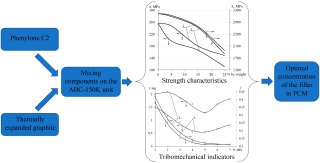Визначення впливу наповнювача на властивості композитних матеріалів на основі фенілону С2 для трибоспряжень механізмів і машин
DOI:
https://doi.org/10.15587/1729-4061.2022.266160Ключові слова:
фенілон С2, термічно розширений графіт, електромагнітне поле, мікроструктура матеріалів, перколяція теплопровідностіАнотація
Впровадження полімерно-композитних матеріалів дозволяє не тільки вирішити проблему підвищення довговічності, зменшення маси та собівартості машин, а й введенням наповнювачів адаптувати їх до необхідних умов експлуатації. При цьому, існує проблема щодо високої собівартості технологій одержання композитів, що обмежує широке їх впровадження.Саме тому, об’єктом дослідження є процеси впливу наповнювача на характеристики та властивості полімерно-композитних матеріалів.
Проведені комплексні лабораторні дослідження фізико-механічних характеристик, трибологічних та теплофізичних властивостей розроблених полімерно-композитних матеріалів на основі фенілону С2. Встановлено залежність коефіцієнту тертя та зносу матеріалу на основі фенілону С2, що містить термічно розширений графіт, від тиску та природи контр-тіл при терті з мащення та без нього. Виявлено, що мінімальна величина зносу матеріалу, при терті без мащення, досягається за тиску на трибоспряження – 5 МПа. Встановлено, що із збільшенням концентрації наповнювача від 5 до 25 мас. % коефіцієнт теплопровідності зростає на 4–40,8 %, у порівнянні з ненаповненим фенілоном С2. Виявлено, що введення термічно розширеного графіту у фенілон С2 у кількості 5 мас. % призводить до зниження теплоємкості на 34 %. Запропонована технологія одержання полімерно-композитних матеріалів в електромагнітному полі забезпечує достатні фізико-механічні характеристики, трибологічні властивості та невисоку собівартість готових виробів (деталей).
Отримані результати дають можливість адаптувати фізико-механічні характеристики, теплофізичні та трибологічні властивості полімерно-композитних матеріалів до певних режимів експлуатації рухомих з'єднань
Посилання
- Hsissou, R., Seghiri, R., Benzekri, Z., Hilali, M., Rafik, M., Elharfi, A. (2021). Polymer composite materials: A comprehensive review. Composite Structures, 262, 113640. doi: https://doi.org/10.1016/j.compstruct.2021.113640
- Dykha, A., Svidersky, V., Danilenko, I., Bilichenko, V., Kukurudzyak, Y., Kirichenko, L. (2020). Design and study of nanomodified composite fluoropolymer materials for tribotechnical purposes. Eastern-European Journal of Enterprise Technologies, 5 (12 (107)), 38–48. doi: https://doi.org/10.15587/1729-4061.2020.214533
- Derkach, O., Artemchuk, V., Muranov, Е. (2017). Regarding to issue of machinability processing the polymeric composites for seeding machines. Visnyk Kharkivskoho natsionalnoho tekhnichnoho universytetu silskoho hospodarstva imeni Petra Vasylenka, 181, 157–166. Available at: http://nbuv.gov.ua/UJRN/Vkhdtusg_2017_181_27
- Aulin, V., Derkach, O., Makarenko, D., Hrynkiv, A., Pankov, A., Tykhyi, A. (2019). Analysis of tribological efficiency of movable junctions “polymericcomposite materials ‒ steel.” Eastern-European Journal of Enterprise Technologies, 4 (12 (100)), 6–15. doi: https://doi.org/10.15587/1729-4061.2019.176845
- Gilbert, M. (2017). Aliphatic Polyamides. Brydson’s Plastics Materials, 487–511. doi: https://doi.org/10.1016/b978-0-323-35824-8.00018-9
- Krasinskyi, V., Suberlyak, O., Sikora, J., Zemke, V. (2021). Nanocomposites based on polyamide-6 and montmorillonite intercalated with polyvinylpyrrolidone. Polymer-Plastics Technology and Materials, 60 (15), 1641–1655. doi: https://doi.org/10.1080/25740881.2021.1924201
- Kabat, O., Sytar, V., Sukhyy, K. (2018). Antifrictional Polymer Composites Based on Aromatic Polyamide and Carbon Black. Chemistry & Chemical Technology, 12 (3), 326–330. doi: https://doi.org/10.23939/chcht12.03.326
- Burya, A. I., Dudin, V. Yu., Burya, A.A., Kholodilov, O. V. (2002). Friction and wear of the aromatic polyamide filled with thermally disintegrated graphite. Trenie i Iznos, 23 (3), 296–299. Available at: https://www.researchgate.net/publication/292487459_Friction_and_wear_of_the_aromatic_polyamide_filled_with_thermally_disintegrated_graphite
- Tomina, A.-M. V., Burya, O. I., Lytvynova, Ye. E., Gavrish, V. M. (2020). The research on the influence of titanium-tantalum-tungsten-cobalt hard alloy on the tribological properties of phenylone C-2. Problems of Tribology, 25 (2), 42–48. doi: https://doi.org/10.31891/2079-1372-2020-96-2-42-48
- Ivanochkin, P. G., Dolgopolov, K. N., Danilchenko, S. A. (2018). Creation of Oil-Filled Composites of Tribotechnical Purpose Based on Aromatic Polyamide Phenylone C-2. Solid State Phenomena, 284, 14–19. doi: https://doi.org/10.4028/www.scientific.net/ssp.284.14
- Ivanochkin, P. G., Danilchenko, S. A., Novikov, E. S. (2016). Antifriction Composites Based on Phenylone C2 for Work under Conditions of Dry Friction. Procedia Engineering, 150, 520–526. doi: https://doi.org/10.1016/j.proeng.2016.07.033
- Dudin, V., Makarenko, D., Derkach, O., Muranov, Y. (2021). Determination of the influence of a filler on the properties of composite materials based on polytetrafluorothylene for tribosystems of mechanisms and machines. Eastern-European Journal of Enterprise Technologies, 4 (12 (112)), 61–70. doi: https://doi.org/10.15587/1729-4061.2021.238452

##submission.downloads##
Опубліковано
Як цитувати
Номер
Розділ
Ліцензія
Авторське право (c) 2022 Volodymyr Dudin, Dmytro Makarenko, Oleksii Derkach, Yevhen Muranov

Ця робота ліцензується відповідно до Creative Commons Attribution 4.0 International License.
Закріплення та умови передачі авторських прав (ідентифікація авторства) здійснюється у Ліцензійному договорі. Зокрема, автори залишають за собою право на авторство свого рукопису та передають журналу право першої публікації цієї роботи на умовах ліцензії Creative Commons CC BY. При цьому вони мають право укладати самостійно додаткові угоди, що стосуються неексклюзивного поширення роботи у тому вигляді, в якому вона була опублікована цим журналом, але за умови збереження посилання на першу публікацію статті в цьому журналі.
Ліцензійний договір – це документ, в якому автор гарантує, що володіє усіма авторськими правами на твір (рукопис, статтю, тощо).
Автори, підписуючи Ліцензійний договір з ПП «ТЕХНОЛОГІЧНИЙ ЦЕНТР», мають усі права на подальше використання свого твору за умови посилання на наше видання, в якому твір опублікований. Відповідно до умов Ліцензійного договору, Видавець ПП «ТЕХНОЛОГІЧНИЙ ЦЕНТР» не забирає ваші авторські права та отримує від авторів дозвіл на використання та розповсюдження публікації через світові наукові ресурси (власні електронні ресурси, наукометричні бази даних, репозитарії, бібліотеки тощо).
За відсутності підписаного Ліцензійного договору або за відсутністю вказаних в цьому договорі ідентифікаторів, що дають змогу ідентифікувати особу автора, редакція не має права працювати з рукописом.
Важливо пам’ятати, що існує і інший тип угоди між авторами та видавцями – коли авторські права передаються від авторів до видавця. В такому разі автори втрачають права власності на свій твір та не можуть його використовувати в будь-який спосіб.










